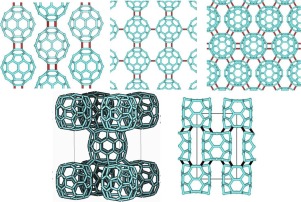Materials Today Communications ( IF 3.7 ) Pub Date : 2020-01-21 , DOI: 10.1016/j.mtcomm.2020.100906 Jorge Laranjeira , Leonel Marques

|
A systematic investigation, using density functional theory (DFT) methods, of the physical properties of one-dimensional (1D), two-dimensional (2D) and three-dimensional (3D) pressure-induced polymerized C60 structures, was performed. The optimized crystal structures, the electronic density of states (DOS) and the bulk moduli B0 were calculated for such polymerized structures, showing how these properties change with the degree of polymerization and providing an overview of the properties of this class of materials. The increasing number of intermolecular bonds, across the low-dimensional polymers, induces a decrease of the electronic bandgap, which in turn vanishes for the metallic 3D polymers. The compressibility behavior of these materials also shows a monotonous dependence on the degree of polymerization: the rise in the number of polymeric bonds induces an expected increase of the bulk modulus. From semiconducting to metallic and from soft to low-compressibility, this class of materials is shown to display an enormous range of electronic and elastic properties.
中文翻译:

C 60结构:结构,电子和弹性
使用密度泛函理论(DFT)方法对压力诱导的聚合C 60结构的一维(1D),二维(2D)和三维(3D)物理性质进行了系统研究。优化的晶体结构,态电子密度(DOS)和体模B 0对此类聚合结构进行了计算,显示了这些性质如何随聚合度变化,并概述了这类材料的性质。跨低维聚合物的分子间键数量的增加导致电子带隙的减小,这对于金属3D聚合物消失了。这些材料的可压缩性也显示出对聚合度的单调依赖:聚合物键数量的增加引起了预期的体积模量的增加。从半导体到金属,再到从柔软到低压缩率,这类材料均显示出广泛的电子和弹性。











































 京公网安备 11010802027423号
京公网安备 11010802027423号